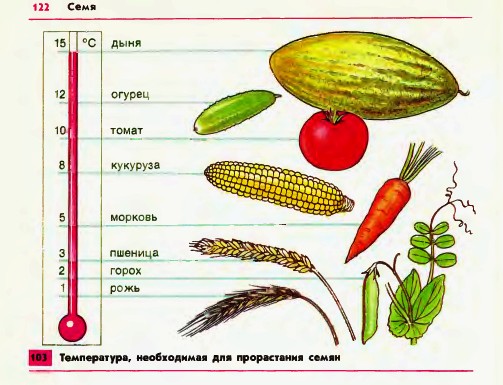Seed germination - Knowledge Hypermarket
>>seed germination
§ 50. Germination of seeds
Grow and give rise to new plant only seeds with a live embryo are capable of. The embryo can die from damage by harmful insects or mold fungi, from drying out during storage, and from other causes. Sometimes the embryos die from too long storage of seeds. Seeds with dead embryos lose their germination capacity, that is, they cannot germinate.
Seed germination is preceded by swelling.
Swelling of seeds is caused by water that penetrates into the seed. Both viable and non-similar swell seeds. Swollen non-germinating seeds rot, and viable ones germinate. For example, when bean seeds germinate, the skin breaks and a young seed appears. root developing from the germinal root. It quickly grows and becomes stronger in the soil. Then the germinal stalk begins to grow, which raises the cotyledons and the kidney above the soil surface. From it develops an aerial bean stalk with leaves. In peas and some other plants, the cotyledons remain in the soil 102 . The above-ground shoot develops from the bud of the embryo.
Seeds can lie in paper bags, in cloth bags, in granaries for a long time without germinating. And the seeds that drank into the ground or placed in a plate with a damp cloth or blotting paper quickly swell and germinate. You were convinced of this by observing the germination of seeds. What conditions are necessary for the embryo to develop?
Experiments will help answer this question.
In two glasses or two small glass jars, the same number of large germinating seeds of cucumbers, oats, rye or wheat is placed. In the first glass, the seeds are left dry. In the second, pour some water on the bottom. We close both glasses with glass and put in a warm place. After 3-4 days in a glass where there was water, the seeds will germinate. In a glass without an ox, the seeds will not change.
Water is essential for seed germination, as the embryo can only consume dissolved nutrients. Seeds of different plants require different amounts of water to germinate. For example, pea seeds absorb water one and a half times their weight. Therefore, the seeds of peas and some vegetable plants are soaked before sowing. Maize grains need 2 times less water than their mass, and for such a drought-resistant cereal as millet, a quarter of the mass of sown grains.
For the second experiment, we put a few grains of rye in two glasses and wheat. Fill the first glass to the brim with water. In the second glass, we only moisten the grains. We cover the glasses with glass and put in a warm place. After 3-4 days, in a glass with a small amount of water, the seeds will germinate. In a glass filled with water, the seeds will swell, but will not germinate, but will die. Here, the water displaced the air from the glass, which the seeds need to breathe.
Seeds of different plants need different amounts of air.
Rice and timothy seeds will germinate even under water with a very small amount of air dissolved in it. The seeds of most flowering plants need an abundance of air and do not germinate under water.
Now let's take two glasses with seeds of the same plants that were used in the first experiment. At the bottom of each glass, pour a little water so that the seeds can germinate. Cover the glasses with glasses.

We put one glass in a warm place, the other in the cold, for example, in a refrigerator, in a cold cellar, or bury it in the snow. When seeds placed in a warm place germinate, compare them with seeds exposed to cold. We will see that the seeds did not germinate in the cold.
Germinating seeds, like water and air, need heat. If seeds have enough water and air, but not enough heat, they will not germinate and eventually die. True, the seeds of some plants, such as rye, can germinate even at one degree of heat. Seeds of most plants germinate only at temperatures of 10-15°C and above. 103 .
So, for the germination of seeds, water, air and heat are needed.
1. What conditions are necessary for seed germination?
2. Why do dry seeds not germinate?
3. How to explain the death of seeds in boiled water?
4. Why should seeds be sown in loose soil?
5. At what temperature do seeds germinate best?
Set up an experiment to find out the effect of temperature on the germination of rye and corn kernels. To do this, sow 30 grains of rye in two boxes, a flowerpot or two special ceramic plates, and 30 grains of corn in the other two. Place one box each with rye and corn crops in a cold room with a temperature of 1-3 ° C, and the other two in a warm room with a temperature of 15-18 ° C. Observe the emergence and development of rye and corn in warm and cold rooms. Record your observations and draw conclusions.
Korchagina V.A., Biology: Plants, bacteria, fungi, lichens: Proc. for 6 cells. avg. school - 24th ed. - M.: Enlightenment, 2003. - 256 p.: ill.
Lesson content lesson summary support frame lesson presentation accelerative methods interactive technologies Practice tasks and exercises self-examination workshops, trainings, cases, quests homework discussion questions rhetorical questions from students Illustrations audio, video clips and multimedia photographs, pictures graphics, tables, schemes humor, anecdotes, jokes, comics parables, sayings, crossword puzzles, quotes Add-ons abstracts articles chips for inquisitive cheat sheets textbooks basic and additional glossary of terms other Improving textbooks and lessonscorrecting errors in the textbook updating a fragment in the textbook elements of innovation in the lesson replacing obsolete knowledge with new ones Only for teachers perfect lessons calendar plan for the year methodological recommendations of the discussion program Integrated Lessons






